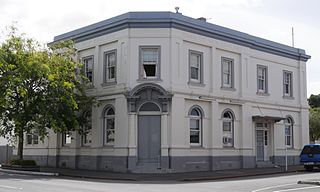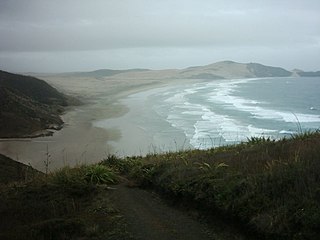Related Research Articles

Kaitaia is a town in the Far North District of New Zealand, at the base of the Aupōuri Peninsula, about 160 km northwest of Whangārei. It is the last major settlement on State Highway 1. Ahipara Bay, the southern end of Te Oneroa-a-Tōhē / Ninety Mile Beach, is 5 kilometres (3.1 mi) west.

Kaikohe is the seat of the Far North District of New Zealand, situated on State Highway 12 about 260 km from Auckland. It is the largest inland town and highest community above sea level in the Northland Region. With a population of over 4000 people it is a shopping and service centre for an extensive farming district and is sometimes referred to as "the hub of the north".

The Okaihau Branch, sometimes known as the Kaikohe Branch and rarely the Rangiahua Branch, was a branch line railway that joined the North Auckland Line of the national rail network of New Zealand at Otiria. It was the most northerly line in New Zealand and was intended to run all the way to Kaitaia. It opened to Ōkaihau in 1923 and closed in 1987.

Opua is a locality in the Bay of Islands, in the sub-tropical Northland Region of New Zealand. It is notable as the first port for overseas yachts arriving in the country after crossing the Pacific Ocean. In the original 1870s plans for the town, it was named Newport. The town of Paihia is nearby, and the small settlement of Te Haumi is in between.
Ōkaihau is a small town in the Northland Region of New Zealand's North Island, just north of Kaikohe. State Highway 1 passes through Ōkaihau making it fairly busy. Ōkaihau has a primary school and a secondary school.

Rangiahua is a small locality near the Hokianga Harbour in the Northland Region of New Zealand. State Highway 1 passes through it. Umawera is to the west, and Okaihau to the east. Rangiahua is part of the Omahuta Forest-Horeke statistical area, which covers the upper Hokianga Harbour. For demographics of this area, see Horeke.
Mangamuka is a district in Northland, New Zealand, at the junction of the Mangamuka and Opurehu Rivers. State Highway 1 runs through the area, and the settlement of Mangamuka Bridge lies at the point where the highway crosses the Mangamuku River. The river runs into the upper Hokianga Harbour. Just to the north west, the highway runs through Mangamuka Gorge in the Maungataniwha Range. Umawera lies to the south east.
Umawera is a community in Northland, New Zealand. State Highway 1 runs through the community. Mangamuka Bridge is to the northwest, and Rangiahua is to the east. Umawera is part of the Omahuta Forest-Horeke statistical area, which covers the upper Hokianga Harbour. For demographics of this area, see Horeke.

Otiria is a rural locality in the Northland Region of New Zealand's North Island. It neighbours Moerewa to the east, with the nearest major town, Kawakawa a few kilometres further eastwards. Other nearby localities include Pokapu to the south, Orauta to the west, and Hupara to the north.
The Awaroa River is a short river in the Far North District of New Zealand. It is 25 kilometres (16 mi) south of Kaitaia, and flows southwest for 12 kilometres (7.5 mi), reaching the Tasman Sea to the north of the Hokianga Harbour. Its estuary forms one of the two arms of Whangape Harbour.
The Mangamuka River is a river of the far north of the Northland Region of New Zealand's North Island. It flows generally south from the Maungataniwha Range southeast of Kaitaia, and the last few kilometres of its length are a wide, silty arm of the Hokianga Harbour, which it reaches 10 kilometres (6 mi) northeast of Rawene.
The Ōpūrehu River is a river of the Northland Region of New Zealand's North Island. It flows south from the eastern end of the Maungataniwha Range to reach the Mangamuka River at the small settlement of Mangamuka.
The Rotokakahi River is a river of the Northland Region of New Zealand's North Island. Its winding course is predominantly southwestward from its origins in the Maungataniwha Range. It reaches the Tasman Sea 25 kilometres (16 mi) south of Kaitaia, and its estuary forms one of the two arms of Whangape Harbour.

The Takahue River is a river of the Northland Region of New Zealand's North Island. It initially flows southwest from its sources in the Maungataniwha Range before turning north. It passes the settlement of Takahue before reaching the Victoria River seven kilometres east of Kaitaia.
Kaikohe Aerodrome is an airfield south-east of Kaikohe in the Northland region of New Zealand. Built in 1942 as a US Marines bomber base, is the largest grass strip in the Southern hemisphere used now by general aviation. Other than powered aircraft, gliders use the airfield, and an area next to the runways is used by model airplane flyers. There are skydiving operations as well, with a landing spot near the old terminal.

Muriwhenua are a group of northern Māori iwi, based in Te Hiku o te Ika, the northernmost part of New Zealand's North Island. It consists of six iwi, Ngāti Kurī, Ngāi Takoto, Te Pātū, Ngāti Kahu, Te Aupōuri and Te Rarawa, with a combined population of about 34,000 people. The spiritually significant Hokianga Harbour, located just to the south of the Maungataniwha Range, is of special significance to the Muriwhenua people.
RNZAF Station Waipapakauri was a Royal New Zealand Air Force station located at Waipapakauri, 14 km north of Kaitaia, Northland Region, New Zealand. Originally established in 1933 as a small local aerodrome, it was commandeered as an air force base by the RNZAF at the outbreak of war in 1939.

The Northland District Health Board is a district health board with the focus on providing healthcare to the Northland Region of New Zealand. In July 2022, the Northland DHB was merged into the national health service Te Whatu Ora.
Northland Conservation Park is a group of protected areas in the Northland Region of New Zealand's North Island.

The Twin Coast Discovery Highway is an 800-kilometre (500 mi) circular road route of Northland, a region located in New Zealand. Most of the route travels on part of State Highway 1 (SH 1), the longest and major road in New Zealand, but some parts spur off onto other roads. It is commonly used as a tourist route, most of the time to visit Cape Reinga. The name "Twin Coast Discovery" is so named because the route up to and back from Cape Reinga are on different coasts.
References
- ↑ "Place name detail: Maungataniwha Range". New Zealand Gazetteer. New Zealand Geographic Board . Retrieved 7 May 2010.
- ↑ "1000 Māori place names". New Zealand Ministry for Culture and Heritage. 6 August 2019.
35°12′04″S173°28′27″E / 35.2012°S 173.4741°E